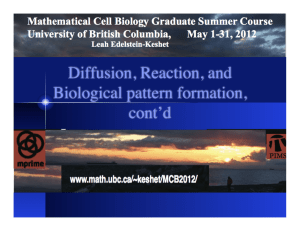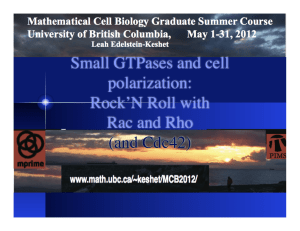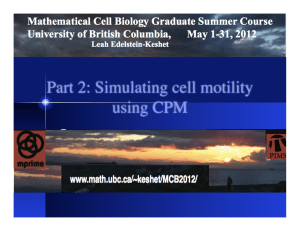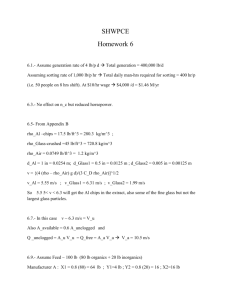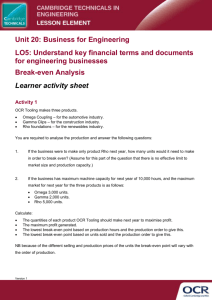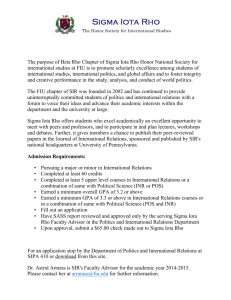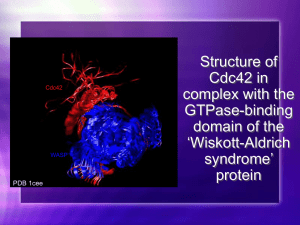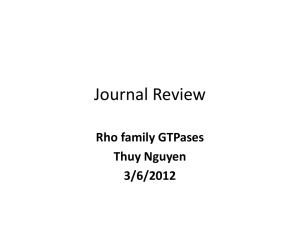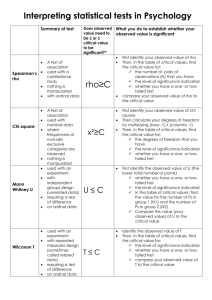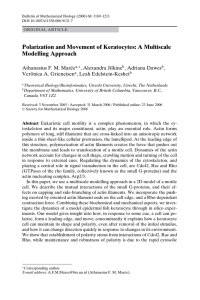Document 11151717
advertisement
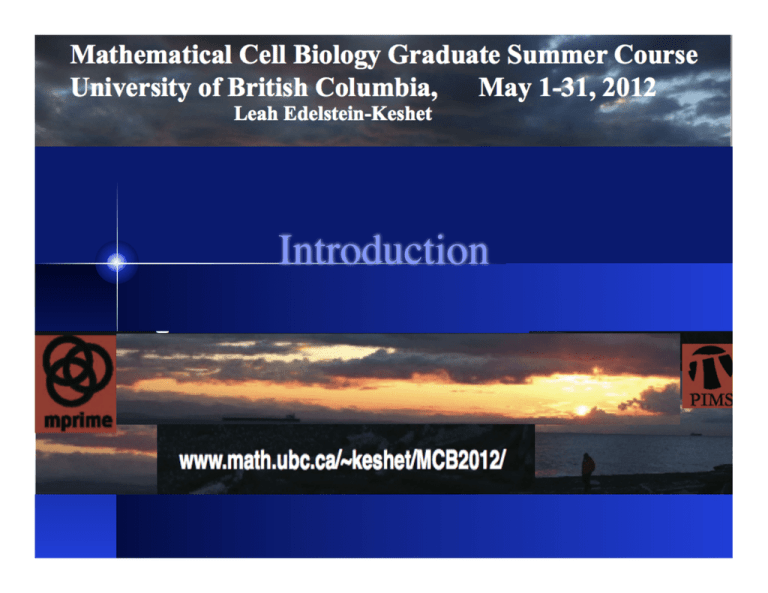
Introduction What are some of the major questions in cell biology? (That require quantitative methods and reasoning) Big questions • How does a cell know when to divide? • How does it coordinate the process of division (“cytokinesis”)? • How do cells move? What guides them? • How do cells sense “directional cues”? • How does a multi-cellular organism get its form/shape? (“morphogenesis”) The mechanisms: Chemistry Mechanics Some movies.. http://www.youtube.com/watch? v=HGkxo2mmLXY http://www.youtube.com/watch?v=I_xh-bkiv_c&feature=fvsr Neutrophil chemotaxis http://www.youtube.com/watch?v=ZUUfdP87Ssg Cells that can crawl Neutrophils: Orion Weiner: http://cvri.ucsf.edu/~weiner/ Slime mold amoeba Figures removed for copyright reasons Tumor Huang et al Nature 2003 keratocytes: Dictyostelium discoideum (WT and Latrunc)" Sasaki et al (2004) JCB, Volume 167, Number 3, 505-518" Svitkina TM, Borisy GG. (1999).J Cell Biol. 31;145(5):1009-26. What’s “under the hood”? Fish keratocyte cytoskeleton Figures removed for copyright reasons Actin meshwork at cell edge (actin) ) Pollard & Borisy (2003) Cell 112: 453-465 The cytoskeleton is dynamic stimuli Actin cycle at leading edge of cell. Figurs removed for copyright reasons Pollard (2003) The cytoskeleton, cellular motility and the reductionist agenda Nature 422: 741-745 It is regulated by biochemical pathways: Intricate internal biochemistry channels stimuli to actin. stimuli actin The pathways are complex www.genome.jp/kegg Have to start somewhere.. Signaling to actin (KEGG): www.genome.ad.jp/kegg highlights credit: A T Dawes Consider signaling “layers” Small GTPAses Phosphoinositides Actin First understand each layer well.. Small GTPAses Phosphoinositides Actin Biochemical polarization Rear Henry Bourne’s Lab RhoA actin Front Polarized distribution in stimulated cells Figurs removed for copyright reasons Cdc42 (red) in front Nabant et al (2004) Science Rac (green) in front (FRET, fibroblast) Krayanov et al (2000), Science. Rho (green) in back actin (red) in front (neutrophil) Bourne lab http://www.cmpharm.ucsf.edu/bourne/ Mutual exclusion: Cdc42 vs Rho Rho Cdc42, Rac Fig panels credit: Jilkine Signaling proteins Rac in stimulated cells Weiner et al (2007) PLoS Biology 5 Rho GTPases (Cdc42, Rac, Rho) crosstalk Schmitz et al (2000) Expt Cell Res 261:1-12 “Front vs Back” Back: Rho PTEN Front: Rac PI3K, PIP2, PIP3 What process(es) account for segregation of chemicals? Consider mathematics of pattern formation Turing: RD systems diffusive instability Local activation Long-range inhibition Meinhardt: Lateral inhibition A.M. Turing, (1952) Phil. Trans. R. Soc. London B237, pp.37-72, 1952 Meinhardt, H. (1999). J. Cell Sci. 112, 2867-2874." What can we suggest? Resting cell Polarize left Polarize right Multiple states Low Cdc42 High Rho High Cdc42 Low Rho More than one persistent state possible: “bistability” Hypothesized crosstalk schemes 2) Giniger (2002): 3) Evers (2000), Sander (1999) + Cdc42 1) Hall (1995): Cdc42 Cdc42 + + + Rac Rac + Rac - Rho Rho - Rho 4) van Leeuwen (1997) 5) Li (2002) Slide courtesy: A. Jilkine Cdc42 Cdc42 + Rac + + Rac + - Rho Rho - Underlying core idea “Wavepinning” Mori Y, Jilkine A, LEK (2008) Biophys J, 94: 3684-3697. Mori Y, Jilkine A, LEK (2011) SIAM J Appl Math What do we want to understand? Chemical polarization Shape change motility Mechanics biochemistry Role of cytoskeleton, forces, and regulation in cell shape and motion “back” Retraction “front” Actin-based Protrusion Pay attention to rates and biological parameters, where available Fraction in active (GTP form), resting cell 3-25% Benard et al (1999) What can we calculate from this? Typical Cdc42 activation rate Typical Rac activation rate Typical Rho activation rate Simplify to get mathematical insights Then go back to more detail.. Rho & actin modules Cdc42 Rac Rho (WASp) (WAVE) (PIP2) (ROCK) (uncap) Arp2/3 Barbed ends Actin filaments Cell protrusion Myosin Rear retraction Ask if your hypothesized network can explain some cell behaviour Filaments Methods: Biological Information Cell motility simulations Biochemical model Mathematical prototypes Understanding basic principles Where is math needed? • Analyse and interpret data. • Put data into context of some hypotheses • Rigorously formulate hypothesis so as to make testable predictions • Rule out impossible mechanisms based on model predictions… • [ FILL IN…] What kinds of math? • Simple models and analysis (ODEs) • Nonlinear dynamics, bifurcations • Spatiotemporal models (PDEs, particle-based) • Simulations.. What are some challenges • Gradually building up complexity • Figuring out what is important.. And what are distracting (unimportant) details • Finding good data/biologists to work with Mathematical tools Can be used in some powerful ways to draw strong conclusions that would otherwise be difficult or impossible to obtain. Example: scaling arguments… Final example for today.. Integrating experiment and theory James Bailey in the Verchere lab Rough Endoplasmic Reticulum Islet Amyloid in Type 2 Diabetes Insulin ? IAPP" Golgi Immature! Mature! Granules! Granules! Beta Cell" (Pro)IAPP (Pro)IAPP Fibrils Fibril Interaction with Beta-Cells Beta Cell Toxicity Macroscopic data to microscopic mechanism Scaling and model
